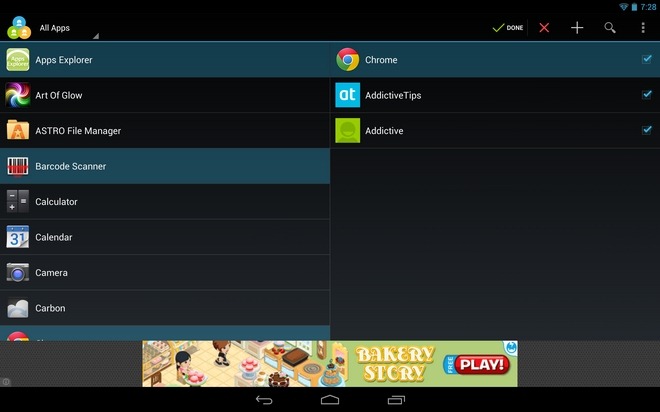Share Apps Between User Accounts On Android 4.2 Tablets With AppShare(+)
Exclusively available to tablet owners, multiple user account support is one of the most significant features introduced in Android 4.2 Jelly Bean. This feature enables you to create multiple user accounts on the same Android tablet, providing each user with a virtual sandboxed environment, complete with personalized layout preferences, apps, storage space, security mechanism, and overall system settings. Since no user is allowed access to other users’ apps, they are left with no choice but to install all the apps afresh from the Play Store separately. This, of course, means that Play Store has to be configured for each account with a Google ID in order to install the apps, even if you’re looking to install just a simple doodling app for your kid. What if you could remove this restriction and share your desired apps with select user accounts on your tablet without compromising your personal app data? Say hello to AppShare(+) – a simple solution for sharing apps with other user accounts on a rooted tablet running Android 4.2 Jelly Bean or higher.
Before installing the app, make sure that you have rooted your tablet. To learn about rooting, please refer to our detailed guide on rooting Android devices.
AppShare(+) allows sharing third-party apps as well as restricting access to system apps for any user account you want. Using the app is quite simple; upon launching it, you’re presented with a couple of panes. The left pane lists your apps, whereas the right pane lists the all the user accounts present on your Android tablet.

Using the dropdown menu at the top-left, you can easily switch between system, third-party and all Android apps on your tablet. To share an app, just tap its title, select the required user account(s) from the right pane, and hit the Done button at the top. When prompted, reboot your device. To confirm whether the app has been successfully shared, select the target user account from the lock screen, head over to the app drawer, and you should be able to see the shared app’s icon there. Since AppShare(+) doesn’t share personal app data and preferences, the other users will have to configure each app afresh as per their own requirements.
By default, all system apps are accessible to all users. To restrict access to a system app for some users, first make sure ‘All Apps’ or ‘System Apps’ is selected in the top-left dropdown. Next, select the app from the left pane and uncheck the username of any users that you want to restrict access for, in the right pane. You can also use the same procedure to revoke access to a third-party app that you had provided to some user earlier on.
AppShare(+) is available in the Play Store as an ad-supported free app. However, through an in-app purchase of $2.99, can you remove ads and gain early access to all the upcoming features in future updates. In addition, the paid version lets you make as many changes to the shared apps’ settings in the same session as required, unlike the free version that requires you to reboot the device after making a maximum of three changes.
Please note that there are some obvious overall limitations of AppShare(+) that you should keep in mind. Apart from requiring root access, AppShare(+) is currently meant to work on Android 4.2 tablets only (since multi-user accounts support is exclusive to Android 4.2 tablets only for now). In order to share paid apps, you’ll have to set up the target user account with the same Google Account that you used for purchasing the app. Also, you might not be able to share certain region-restricted apps such as Google Wallet and several others anyway. AppShare(+) was successfully tested on Nexus 10.
Download AppShare(+) For Android

It seems like every version of the Android operating system requires a completely different set up of instructions for doing simple things like sharing an app between multi users on a device.